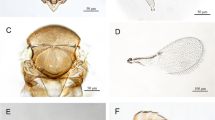Abstract
To date, the North Caucasus, particularly the territory of Stavropol Territory, is traditionally indicated as the habitat of the tick Ixodes crenulatus Koch, 1844. I. kaiseri Arthur, 1957 was previously known only from a single site in the Eastern Ciscaucasia. Re-examination of collections from the North Caucasus and Transcaucasia has shown that the overwhelming majority of the specimens from these regions belong to the species I. kaiseri, allowing the revision of common views on the range boundaries of both species.
Similar content being viewed by others
References
Dzhaparidze, N.I., Ixodid Ticks of Georgia (Tbilisi, 1960) [in Russian].
Emelyanova, N.D., “The Taxonomic Position of Ixodid Ticks of the Genus Pholeoixodes in the Subfamily Ixodinae and Its Subdivision into Subgenera,” in Zooparasitology of the Lake Baikal Basin (Ylan-Ude, 1979) pp. 5–27.
Filippova, N.A., Ixodid Ticks of the Subfamily Ixodinae. Fauna of USSR, Vol. 4, No. 4, Arachnoidea (Nauka, Leningrad, 1977) [in Russian].
Guglielmone, A.A., Robbins, R.G., Apanaskevich, D.A., Petney, T.N., Estrada-Pena, A., and Horak, I.G., The Hard Ticks of the World (Acari: Ixodida: Ixodidae) (Springer, Dordrecht, 2014).
Gusev, V.M., Bednyi, S.N., Labunets, N.F., and Bakeev, N.N., “Ecological Groups of Birds of the Caucasus and Their Role in Life of Ticks and Fleas,” Trudy Nauchno-Issledovatelskogo Protivochumnogo Instituta Kavkaza i Zakavkaziya 5, 217–267 (1961).
Guseva, A.A., “On the Study of the Fauna of Ixodid Ticks of Stavropol Territory,” Trudy Azerbaijanskoi Protivochumnoi Stantsii 3, 228–235 (1962).
Kalita, S.R. and Pelipeichenko, M.V., “On the Knowledge of the Ixodid Tick Fauna of Krasnodar Territory,” Zoologicheskii Zhurnal 36 (6), 947–948 (1957).
Kolonin, G.V., World Distribution of Ixodid Ticks. The Genus Ixodes (Nauka, Moscow, 1981) [in Russian]
Marutyan, E.M., “The Fauna of Ixodid Ticks of Chechen-Ingush ASSR,” Trudy Vsesoyuznogo Instituta Experimentalnoi Veterinarii 28, 91–97 (1963).
Nelzina, E.N., Slinko, L.I., Kadatskaya, K.P., Ivanov, K.A., Yamshchikova, Kh.G., Poltavtsev, N.N., Skirda, G.I., “Ixodid Ticks (Parasitiformes, Fam. Ixodidae) of Rodents in the Northwestern Caspian Region” in Collection of Works of Astrakhan Anti-Plague Station. Vol. 1 (1955), pp. 416–433.
Shatas, Ya.F., “An Ecological and Faunistic Essay on Ixodid Ticks of Stalingrad Province and Northern Regions of Astrakhan Province in Connection with Erection of New Buildings,” Zoologicheskii Zhurnal 31 (6), 802–818 (1952).
Shatas, Ya.F., “Ticks Ixodoidea and Fleas of Daghestan,” in Scientific Conference on Natural Focality and Epidemiology of Extremely Dangerous Infection Diseases (1957), pp. 433–437.
Sonenshine D. E., Kohls G. M., Clifford C. M. “Ixodes crenulatus Koch, 1844. Synonymy with I. kaiseri Arthur, 1957 and Redescriptions of the Male, Female, Nymph, and Larva (Acarina: Ixodidae),” Acarologia 11 (2), 193–206 (1969).
Tiflova, L.A., Reznik, P.A., Popova, E.V., “Ixodid Ticks of Stavropol Territory and Their Medical Importance,” in Vectors of the Most Dangerous Infection and Their Control (1970), pp. 459–471.
Tsapko, N.V., “Ixodid Ticks of the Genus Ixodes Latreille, 1795 of the North Caucasus Fauna: Species Diversity, Host-Parasite Relations, and Role in Supporting of Transmissive Infections,” in Actual Problems of Diseases Common for Humans and Animals (Stavropol, 2017), pp. 198–199 [in Russian]
Tsapko, N.V., “Ixodid Ticks (Acari, Ixodidae) of the North Caucasus: Species Composition, Host- Parasite Relations,” Parazitologyia 51 (2), 104–120 (2017).
Author information
Authors and Affiliations
Corresponding author
Additional information
Original Russian Text © N. V. Tsapko, 2018, published in Parazitologiya, 2018, Vol. 51, No. 6, pp. 528—533.
Rights and permissions
About this article
Cite this article
Tsapko, N.V. The Tick Ixodes kaiseri (Acari, Ixodidae) in the North Caucasus and Transcaucasia According to the Material from the Collection of Stavropol Anti-Plague Institute. Entmol. Rev. 98, 125–128 (2018). https://doi.org/10.1134/S0013873818010116
Received:
Published:
Issue Date:
DOI: https://doi.org/10.1134/S0013873818010116




